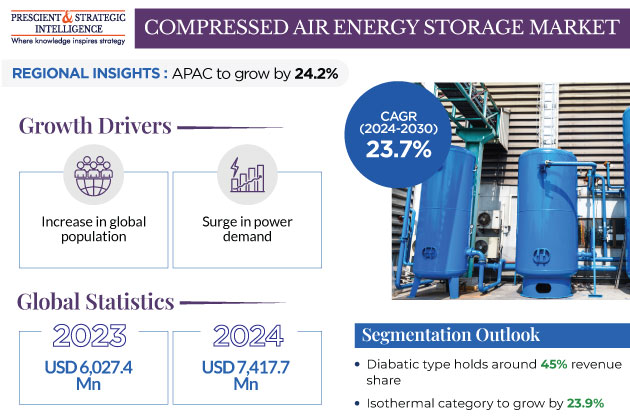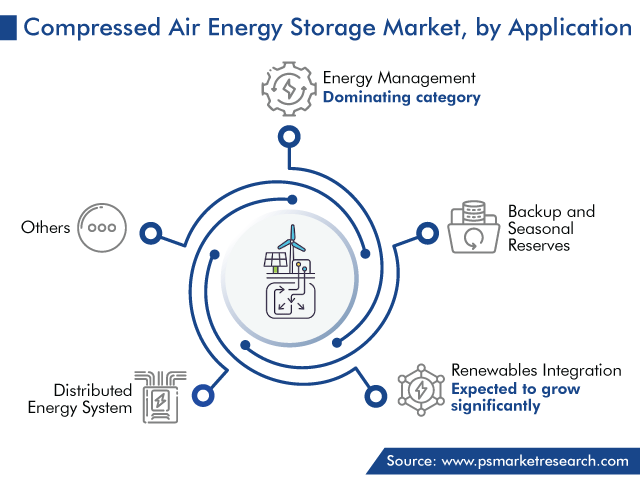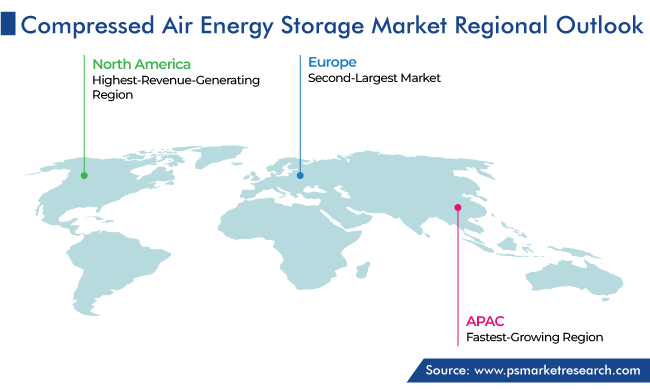Report Code: 11933 | Available Format: PDF | Pages: 240
Compressed Air Energy Storage Market Size and Share Analysis by Type (Adiabatic, Diabatic, Isothermal), Storage (Traditional, Liquid Gas), Application (Energy Management, Backup and Seasonal Reserves, Renewables Integration, Distributed Energy System) - Global Industry Demand Forecast to 2030
- Report Code: 11933
- Available Format: PDF
- Pages: 240
- Report Description
- Table of Contents
- Market Segmentation
- Request Free Sample
Market Overview
The global compressed air energy storage market revenue is estimated to have stood at USD 6,027.4 million in 2023, and it is predicted to reach USD 26,605.3 million by 2030, advancing at a CAGR of 23.7% during 2024–2030. This is attributed to the increase in the global population and the resulting surge in the overall power demand. According to reports, global energy consumption rose from around 122.8 TWh in 2000 to over 178.8 TWh in 2022.
Innovations in present energy devices are imperative to establish an equilibrium in the distribution of power as per demand. As electricity is essential in today's era, the retention of any additional energy generated for future use has gained significant importance. One of the technologies, compressed air energy storage (CAES) is a method of storing power in compressed air, which is released and heated to drive a conventional turbine when extra electricity is needed.

The disparity between energy demand and distribution is noticeable in the lower requirement throughout the night and a high demand during the day. CAES helps both public and private corporations in the effective management of electricity demand, by storing electricity in the form of compressed air during intervals of low demand. The stored air is used to power turbines and generate electricity when demand peaks. This technology is widely used for its cost-effectiveness, superior efficiency, and lower maintenance needs in comparison to others.
The compressed air energy storage market is expected to experience growth during the forecast period due to the integration of renewables with these systems, technological advancements in them, and the execution of demonstration projects.
Diabatic Type Holds Largest Share
Based on type, the diabatic category held the largest share in 2023, of 45%. A D-CAES system compresses air and stores it in geological underground voids, such as salt caverns; or other suitable media, including aquifers, hard rocks, and under-development gas fields. The stored energy can generate electricity by heating air, by burning natural gas. This extra heat causes the air to expand, which drives conventional gas turbines, causing the generators to produce electricity.
D-CAES plants generally have lower operating costs compared to isothermal and adiabatic plants, making them more affordable in the long run. However, they are less environment-friendly because they rely on gas combustion. Moreover, even though this system attains an efficiency of only 50%, it is the most popular, as in 2020, it was the only commercialized variant around the world.
The first D-CAES facility, which was known as the Huntorf CAES plant, was built in 1978 in Germany. It had an efficiency of only about 40% and a capacity of 298 MW. The second facility was established in Alabama, U.S., with a capacity of 110 MW and a targeted efficiency exceeding 50%. According to the U.S. Energy Information Administration (EIA), the Alabama system’s total gross generation was 23,234 MWh in 2021.
The adiabatic category could offer lucrative opportunities in the future as these systems achieve a 20% higher efficiency than diabatic systems. This is because this approach saves the heat generated during compression and uses it during expansion.
Isothermal Category To Witness Rapid Growth
The isothermal category is predicted to grow at a CAGR of 23.9% in the forecast period, as this approach can achieve a perfect or nearly perfect heat exchange with the surroundings. This is because it allows for twice the amount of air compression compared to adiabatic systems. For this reason, the long-term expenses on an isothermal CAES system are nearly 14% lower than that of traditional procedures.
Furthermore, this variant has a theoretical conversion efficiency of 100% and a practical limit of 80%, which is still way higher than the other two variants. Such a system reaches a state of equilibrium between the external and internal temperatures; thus, heat dissipates into the atmosphere during the compression process. Afterward, when the compressed air is released to drive the turbine and generate electricity, heat is absorbed from the surrounding environment. However, it has not been practiced on a large scale yet as heat loss to a certain degree is inevitable.
| Report Attribute | Details |
Market Size in 2023 |
USD 6,027.4 Million |
Market Size in 2024 |
USD 7,417.7 Million |
Revenue Forecast in 2030 |
USD 26,605.3 Million |
Growth Rate |
23.7% CAGR |
Historical Years |
2017-2023 |
Forecast Years |
2024-2030 |
Report Scope |
Market Trends, Drivers, and Restraints; Revenue Estimation and Forecast; Segmentation Analysis; Impact of COVID-19; Companies’ Strategic Developments; Market Share Analysis of Key Players; Company Profiling |
Segments Covered |
By Type; By Storage; By Application; By Region |
Explore more about this report - Request free sample
Energy Management Application Leads Market
The energy management category will generate the highest revenue in 2030 under the application segment, of more than USD 9 billion. Energy management is a systematic process involving the monitoring and enhancement of energy usage within a building, to reduce the overall consumption and indirect GHG emissions. This process consists of several key steps, such as continuous data collection & analysis to identify opportunities to improve energy efficiency through optimizing equipment schedules and flow rates and setting parameters.
To accomplish energy management goals, renewable sources can be employed to maximize the flexibility of CAES. These systems are reliable and easily accessible, which makes them well-suited to meet energy goals at the enterprise, city, or national level.
CAES power stations generate and store electricity efficiently, thus helping maintain grid stability and manage energy demand. These power stations are used for peak load management and load shifting, the latter of which involves the shifting of energy consumption from low- to high-demand periods. They also aid in enhancing grid stability by offering frequency and voltage control, by rapidly responding to the fluctuations in the grid supply. This way this technology enhances the resilience of the grid by serving as a reliable backup power source during unexpected outages or emergencies.
The distributed energy systems (DES) category is expected to witness significant growth in revenue generation in this decade. DESs are deployed to integrate the CAES technology into localized or decentralized and, often, small energy generation and storage facilities. Their storage capacity can be distributed across various locations, rather than relying on a single large-scale facility.

North America To Dominate Global Market
North America is the highest revenue contributor to the global market, as the energy landscape in the U.S. is undergoing a substantial transformation with coal-based power generation being swiftly replaced with natural gas. This shift is propelled by the reducing prices and substantial environmental benefits of natural gas over coal. Concurrently, the incorporation of renewable sources into the country’s energy mix is growing. Further, to ensure the stability of the nation's aging grid, there is a strong focus on its upgradation, expansion, and advancement. For instance, a natural gas CAES project located in Texas with a capacity of 317 MW is planned for completion in 2025.
Essentially, as the U.S. strives to lower carbon emissions across its states, the share of sustainable energy in its electricity mix is expected to increase. With the nation’s growing dependence on sustainable power sources, the issue of a consistent supply becomes more severe. Given the influence of variable weather conditions on renewable energy generation, there would be an increase in the demand for efficient energy storage solutions over the forecast period.

Asia-Pacific Is Fastest-Growing Region
Till 2030, the highest CAGR, of 24.2%, is expected to be seen in the APAC region. The growth of the regional market is mainly due to the rapid deployment of technologies that generate and store energy to achieve long-term climate sustainability goals in China, India, Japan, and other nations. For instance, in September 2022, a 100-MW advanced CAES facility was integrated into China's power generation network.
Key Players in Compressed Air Energy Storage Market Are:
- Siemens AG
- Hydrostor Inc.
- Pacific Gas and Electric Company
- Apex Compressed Air Energy Storage LLC
Market Breakdown
This report offers deep insights into the compressed air energy storage market, with size estimation for 2017 to 2030, the major drivers, restraints, trends and opportunities, and competitor analysis.
Segment Analysis, By Type
- Adiabatic
- Diabatic
- Isothermal
Segment Analysis, By Storage
- Traditional
- Liquid Gas
Segment Analysis, By Application
- Energy Management
- Backup and Seasonal Reserves
- Renewables Integration
- Distributed Energy System
Region/Countries Reviewed for this Report
- North America
- U.S.
- Canada
- Europe
- Germany
- U.K.
- France
- Italy
- Spain
- Asia-Pacific
- Japan
- China
- India
- South Korea
- Australia
- Latin America
- Brazil
- Mexico
- Middle East and Africa
- Saudi Arabia
- South Africa
- U.A.E.
The 2030 revenue of the market for compressed air energy storage solutions will be USD 26,605.3 million.
The compressed air energy storage industry has a CAGR of 23.7%.
The market for compressed air energy storage solutions is propelled by the rising electricity demand and increasing renewables integration.
The diabatic category leads the compressed air energy storage industry.
Adiabatic and isothermal CAES could be great investment areas in the market for compressed air energy storage solutions.
Energy management applications generate the highest compressed air energy storage industry revenue.
North America is the largest and APAC the fastest-growing market for compressed air energy storage solutions.
Want a report tailored exactly to your business strategy?
Request CustomizationWant an insight-rich discussion with the report author?
Speak to AnalystOur dedication to providing the most-accurate market information has earned us verification by Dun & Bradstreet (D&B). We strive for quality checking of the highest level to enable data-driven decision making for you
Our insights into the minutest levels of the markets, including the latest trends and competitive landscape, give you all the answers you need to take your business to new heights
With 24/7 research support, we ensure that the wheels of your business never stop turning. Don’t let time stand in your way. Get all your queries answered with a simple phone call or email, as and when required
We take a cautious approach to protecting your personal and confidential information. Trust is the strongest bond that connects us and our clients, and trust we build by complying with all international and domestic data protection and privacy laws